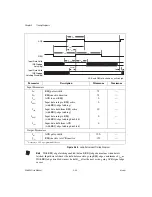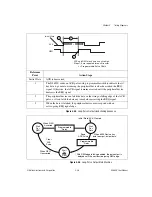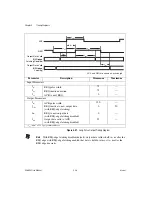
Chapter 3
Timing Diagrams
3-22
ni.com
Using Protocols Based on Signal Edges
The NI 653
X
can communicate using pulses on the ACK and REQ lines.
The three edge protocols are:
•
Trailing-edge protocol—The trailing edge of the ACK or REQ pulse
indicates that the NI 653
X
or peripheral device is ready for a transfer.
•
Leading-edge protocol—The rising edge of the ACK or REQ pulse
indicates that the NI 653
X
or peripheral device is ready for a transfer.
•
Long-pulse protocol—This protocol is a variant of the leading-edge
protocol, with the additional option of using a data-settling delay. If
your application requires a large minimum pulse width, use this
protocol. In this case, the programmable delay is used to increase the
ACK pulse width instead of delaying the ACK pulse.
You can also use long-pulse protocol to handshake with an actual 8255 or
82C55 PPI. You must set the ACK and REQ signals to active low and select
a minimum pulse width of 500 ns for your 8255 or 82C55.
Using the Trailing-Edge Protocol
Figure 3-20.
Trailing-Edge Input Handshaking Sequence
Reference
Point
Action Steps
Initial State
ACK is deasserted. The NI 653
X
waits for the peripheral device to pulse REQ to
indicate it has data.
1
The NI 653
X
sends an ACK pulse of programmable width when ready to receive
data.
2
After receiving the trailing edge of the ACK pulse, the peripheral device can
strobe data into the NI 653
X
and pulse the REQ.
3
The NI 653
X
sends another ACK pulse when ready for another input.
ACK
REQ
2
1
ACK and REQ are shown as active high.
Steps 1–2 are repeated for each transfer.
3
Initial State
Data Latched
Data Valid
Содержание NI 653 Series
Страница 1: ...PCI 6533...
















































